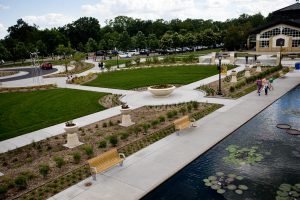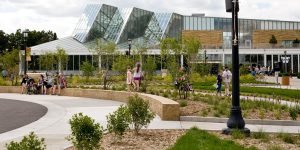Article and photos by MARGIE O’LOUGHLIN
The formal design of the newly completed Minnesota and Circle Gardens at Como Zoo and Conservatory is a graceful nod to the past—and the future. When the Marjorie McNeely Conservatory was built over 100 years ago, in front of it was an extensive formal garden. The historic plantings there began to be removed in the 1920’s. Each decade that followed saw the diminishment of Aphrodite’s Garden, the Iris Garden, the Peony Garden, as they were called, and finally, even the signature pergola was removed.
 Photo left: Michelle Furrer (on the left), Como Park Zoo and Conservatory campus manager; and Brett Hussong, landscape architect with St. Paul Parks and Recreation Department. Both agreed that, “With this project, it wasn’t about getting bigger – it was about getting better.” Furrer and Hussong were two of the primary members of the redesign team.
Photo left: Michelle Furrer (on the left), Como Park Zoo and Conservatory campus manager; and Brett Hussong, landscape architect with St. Paul Parks and Recreation Department. Both agreed that, “With this project, it wasn’t about getting bigger – it was about getting better.” Furrer and Hussong were two of the primary members of the redesign team.
When Como Conservatory was built in 1915, visitors arrived by public transportation in the form of street cars. Street cars were retired in the mid-1950’s, and by 1974, the formal gardens—the first thing visitors saw—were completely replaced with a parking lot. That area became open turf in 2005 when the current Visitor Center was built.
 Photo right: The new Minnesota and Circle Gardens have a formal geometry with plant lined paths connecting the Marjorie McNeely Conservatory, the entrance to the Visitor Center, and the Carousel. All plant materials purchased for the project follow a City of St. Paul ordinance that requires plants to be grown free of pesticides, benefiting insects including butterflies and honey bees.
Photo right: The new Minnesota and Circle Gardens have a formal geometry with plant lined paths connecting the Marjorie McNeely Conservatory, the entrance to the Visitor Center, and the Carousel. All plant materials purchased for the project follow a City of St. Paul ordinance that requires plants to be grown free of pesticides, benefiting insects including butterflies and honey bees.
Como Zoo and Conservatory’s 1996 Master Plan recommended bringing back some of the early design elements and plantings. With the completion of the Minnesota and Circle Gardens in early June, this has been achieved.
According to Brett Hussong, landscape architect with the City of St. Paul Parks and Recreation Department, “The new gardens feature 5,000 Minnesota native cultivars including lupine, blazing star, black-eyed Susan, allium, trillium, serviceberry, bee balm, and red bud. All of the plants in the ground are native Minnesota perennials; hardy plants that will come back year after year.” Hussong concluded, “It was a challenging design project because of the scale, and because we needed to create strong seasonal variety.”
 Photo left: Abundant, informal seating was created with several low, curved benches. Cast from colored concrete, the benches were made to resemble the Kasota Limestone which figures strongly into the design of the Visitor Center (visible in the background).
Photo left: Abundant, informal seating was created with several low, curved benches. Cast from colored concrete, the benches were made to resemble the Kasota Limestone which figures strongly into the design of the Visitor Center (visible in the background).
Funding for the new gardens came from the non-profit organization Como Friends and from the Legacy Amendments Arts and Cultural Heritage Fund.
Campus Manager Michelle Furrer, said, “We knew we needed to make Como Park Zoo and Conservatory a more accessible venue. Incorporated into the new design is a circle turnaround that provides a safe, convenient loading and unloading spot for school buses, guests with limited mobility, and larger groups. Three buses can unload simultaneously, with enough room left over for cars to pass.”
 “We’ve also relocated our Como Shuttle drop off spot,” Furrer said, “in hopes of easing traffic flow for both pedestrians and drivers. We estimate that the shuttle moves about 40,000 passengers from the State Fairgrounds to the Zoo and Conservatory each year, so that should be a big improvement.”
“We’ve also relocated our Como Shuttle drop off spot,” Furrer said, “in hopes of easing traffic flow for both pedestrians and drivers. We estimate that the shuttle moves about 40,000 passengers from the State Fairgrounds to the Zoo and Conservatory each year, so that should be a big improvement.”
The Minnesota and Circle Gardens combine native Minnesota plants with flowing pathways, natural gathering spaces defined by comfortable seating, and more efficient access in and out of the campus. The enormous planter bowls stocked with flowers are reminiscent of those used in the original design of Aphrodite’s Garden at the turn of the last century.
Casto Solano’s 16’ tall sculpture (photo right) of prairie grasses and fireflies (whose tails are illuminated with LED bulbs), charts a path forward. “It will show us how important it is to follow a path of preservation and caring for the future,” Solano said. “Perhaps we too can become conscious of the grandness of small things.”
Comments
No comments on this item Please log in to comment by clicking here